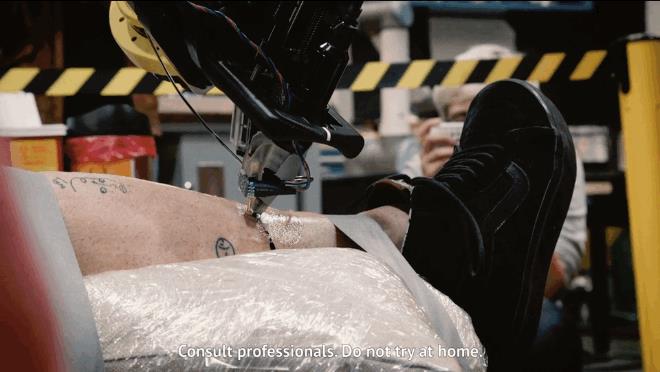 For many, tattoos are permanent marks of human individualism. From the movements of the tattoo artist’s careful hand to the expressive results etched in ink on the skin, tattoos are often rooted in human uniqueness; that is, unless your tattoo artist was a robot. Engineered by French designers Pierre Emm, Johan da Silveira, and Piotr Widelka, Tatoué is one of the world’s first robot tattooists, eager to come to a tattoo parlor near you.
For many, tattoos are permanent marks of human individualism. From the movements of the tattoo artist’s careful hand to the expressive results etched in ink on the skin, tattoos are often rooted in human uniqueness; that is, unless your tattoo artist was a robot. Engineered by French designers Pierre Emm, Johan da Silveira, and Piotr Widelka, Tatoué is one of the world’s first robot tattooists, eager to come to a tattoo parlor near you.
Industrial robots are designed for automating manufacturing jobs, faithfully programmed to perform the redundant, dangerous, and dirty tasks too demeaning for humans. Tatoué is designed to push that envelope, focusing on performing a more sophisticated and intimate task with humans.
Erected from a Maker 3D printer with a tattoo gun, Tatoué is a sophisticated industrial robot that brings the precision of automation to the artistic pursuit of tattooing. Unlike the clear-cut movement path programmed for manufacturing, adjusting a robot to recognize to the curves and uneven surfaces of the human body was no easy feat.
First, the team took a 3D scan of the area where the tattoo would be placed. A virtual design mockup was then created using the parametric design environment Dynamo, which employs algorithms to generate a list of parameters and rules based on the intended tattoo design. Dynamo can then generate a code clarifying the relationship between the tattoo design and the geometry of the human form, which will be exported as an instruction set to the robot.
While the steady arm of a robot can produce flawless work, the result is still dependent on the stillness of the human subject. Researchers worked tirelessly to control the entire energy expenditure of a large industrial robot onto the single point of a needle, meaning any unexpected movement could not only ruin the design but could be potentially harmful to humans.
As for the future of Tatoué, Emm and de Silveira say they eventually plan to turn the project into a commercial operation. “It was not the goal in the beginning, but many of the tattoo artists and studios we have worked with along the way are impatient to get their hands on these machines,” said the pair.
As robots begin making the transition from automated tasks to artistic endeavors, a robot tattoo artistic could be the first of many machines to mechanize such a “unique” human undertaking.
Advertisement
Learn more about Electronic Products Digital





